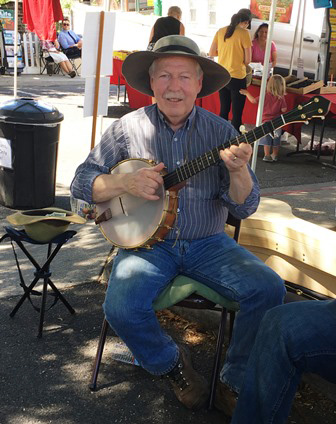About the Luthier
My Life with the 5-String Banjo
The banjo and I have a long history: more than 60 years. I first heard one being played on records by ‘The Kingston Trio’ in the 1950’s. I was about 8 years old. Within a few years, I discovered the music of Pete Seeger and then, about 1960, his half-brother Mike Seeger and the ‘New Lost City Ramblers.’ They played very authentic versions of early 20th century rural American string band music.
The banjo and fiddle were central to most of this music. I had no idea of how they played the banjo but I loved the sound! The way that it is used to supply rhythm and to compliment the melody at the same time still is exciting to me.
By 1963, my sister gave me a copy of Pete Seeger’s ‘How to Play the 5-String Banjo’. Now I Really wanted to play the banjo but I didn’t have one.
So, using the cover drawing on Pete’s book, I built one. It cost me $10. As you can guess, it was a bit crude. For this reason and that there were no banjo players or teachers where I lived (Fairfield, CA), it took me a long time to learn. With records (many re-recorded 78’s) and Pete’s book, I eventually learned a version of a few tunes. One of my first was ‘Cripple Creek’. I was trying both claw hammer and 3-finger styles.
After high school I attended U.C. Davis. There I met some talented musicians who happened to be just discovering this Old Time music that I was trying to play. They put up with my beginner skills and by playing with them (initially in the next room) I started to develop the style that I still use today. I learned to listen to the fiddle part and make up a banjo part to compliment this. I used some tablature to learn some phrases but most importantly I learned to play by ear.
I moved with my wife, Janet, and young family to Sonora in 1978. I worked as a Family doctor there until 1999. During this time, I continued to play banjo on my own as there weren’t any other Old Time musicians here. In the late 1990’s, a couple of dance callers moved here and we started a monthly contra/barn dance. We’ve been doing this for more than 20 years with a walk-on band. This has given me a chance to learn from a variety of fiddlers. I love playing this music for dance; emphasizing rhythm but also adding to the fiddle melody as well.
While playing for these dances, I started to think of ways to re-design the banjo sound chamber.  It is basically a cylinder; not the best acoustic shape. I added a variety to air spaces within or attached to the rim to add more variety of sympathetic tones. These are made of tone woods to achieve a timbre closer to some of the early 19th century banjos built by African Americans. All banjos originated from African instruments brought to America by these enslaved people.
It is basically a cylinder; not the best acoustic shape. I added a variety to air spaces within or attached to the rim to add more variety of sympathetic tones. These are made of tone woods to achieve a timbre closer to some of the early 19th century banjos built by African Americans. All banjos originated from African instruments brought to America by these enslaved people.
Currently, I build 3 models: ‘Wood-o-Phone’, ‘Chromatic’ and ‘Cello’ (octave) banjos for sale.
I have written more details about their development and construction elsewhere. My story isn’t done; I’ll continue to develop new designs for as long as I’m able to.